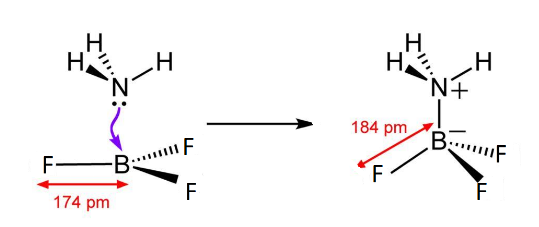Answer
64.8k+ views
Hint: \[N{H_3}\] is electron rich as it has a lone pair and \[B{F_3}\] is electron deficient, due to this, ammonia donates its electron pair to \[B{F_3}\] , which has vacant orbital that takes up electrons and completes its octet by forming a coordinate bond and changing its hybridisation.
Complete step-by-step solution:
\[N{H_3}\] is an electron-rich species with a lone pair on a Nitrogen atom and so it is always ready to either share or donate this lone pair to other species. Therefore, it is known as a Lewis base. Lewis bases can donate a pair of non-bonding electrons.
While, \[B{F_3}\] is an electron-deficient species having vacant orbitals with an incomplete octet of Boron. So \[B{F_3}\] always looks for species which can donate electrons to it and complete its octet. Therefore, it is known as Lewis acid. These are electron acceptors.
So, when they come close to each other to form a bond, an ammonia molecule coordinates its lone pair to the empty p-shell or vacant p-orbitals of Boron forming a co-ordinate bond to give rise to an adduct which looks like this.

\[B{F_3}\] has a hybridisation of \[s{p^2}\] because of filling of 2s and 2 orbitals of 2p. But as it forms coordinate bond with ammonia, the lone pair accepted from ammonia leads to bond pair and lone pair repulsion, changing its shape from trigonal planar to tetrahedral and hybridisation from \[s{p^2}\] to \[s{p^3}\] due to filling of one more 2p orbital. This makes the system highly stable by removing the electron deficiency of boron.
Hence, the correct option is (B).
Note: As per molecular orbital theory, one can also understand this concept as the HOMO on the Lewis base (\[N{H_3}\]) interacts with the electron pair in the LUMO of the Lewis acid (\[B{F_3}\]). This forms an adduct of these molecular orbitals and lowers the energy by stabilizing it.
Complete step-by-step solution:
\[N{H_3}\] is an electron-rich species with a lone pair on a Nitrogen atom and so it is always ready to either share or donate this lone pair to other species. Therefore, it is known as a Lewis base. Lewis bases can donate a pair of non-bonding electrons.
While, \[B{F_3}\] is an electron-deficient species having vacant orbitals with an incomplete octet of Boron. So \[B{F_3}\] always looks for species which can donate electrons to it and complete its octet. Therefore, it is known as Lewis acid. These are electron acceptors.
So, when they come close to each other to form a bond, an ammonia molecule coordinates its lone pair to the empty p-shell or vacant p-orbitals of Boron forming a co-ordinate bond to give rise to an adduct which looks like this.

\[B{F_3}\] has a hybridisation of \[s{p^2}\] because of filling of 2s and 2 orbitals of 2p. But as it forms coordinate bond with ammonia, the lone pair accepted from ammonia leads to bond pair and lone pair repulsion, changing its shape from trigonal planar to tetrahedral and hybridisation from \[s{p^2}\] to \[s{p^3}\] due to filling of one more 2p orbital. This makes the system highly stable by removing the electron deficiency of boron.
Hence, the correct option is (B).
Note: As per molecular orbital theory, one can also understand this concept as the HOMO on the Lewis base (\[N{H_3}\]) interacts with the electron pair in the LUMO of the Lewis acid (\[B{F_3}\]). This forms an adduct of these molecular orbitals and lowers the energy by stabilizing it.
Recently Updated Pages
Write a composition in approximately 450 500 words class 10 english JEE_Main

Arrange the sentences P Q R between S1 and S5 such class 10 english JEE_Main

What is the common property of the oxides CONO and class 10 chemistry JEE_Main

What happens when dilute hydrochloric acid is added class 10 chemistry JEE_Main

If four points A63B 35C4 2 and Dx3x are given in such class 10 maths JEE_Main

The area of square inscribed in a circle of diameter class 10 maths JEE_Main



